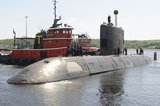RNZN’s second frigate returns after prolonged upgrade
HMNZS Te Mana arrives in New Zealand following a prolonged upgrade undertaken by Lockheed Martin Canada. (Photo: NZDF)
HMNZS Te Mana of the Royal New Zealand Navy (RNZN) arrived home at Devonport Naval Base in Auckland on 8 July, after an astonishing 1,200-day absence from the country.
Indeed, Te Mana had been away for so long that the warship was entitled to a ceremonial homecoming. The Anzac-class frigate returned with 170 crew aboard after its extensive Frigate System Upgrade (FSU).
Prime systems integrator Lockheed Martin Canada performed the FSU work at Seaspan Shipyards in Victoria, Canada, following a 2014 contract award. Te Mana commenced its FSU on 1 May 2019.
Both New Zealand frigates were supposed to be
Already have an account? Log in
Want to keep reading this article?
More from Naval Warfare
-
![Will the US Navy surge production for OTH-WS missile?]()
Will the US Navy surge production for OTH-WS missile?
The USN is conducting a market search seeking additional sources capable of supplying 516 units of Over the Horizon – Weapons System Encanistered Missiles.
-
![How will SAFE shape naval procurement for Canada and its highest-receiving members?]()
How will SAFE shape naval procurement for Canada and its highest-receiving members?
Canada’s inclusion on the EU’s Security Action for Europe initiative is set to enhance the country’s defence procurement strategy with important implications for some of its naval programmes, while Poland and Romania have also secured significant SAFE funding.
-
![Thales wins DE&S contract for portable autonomous command centres]()
Thales wins DE&S contract for portable autonomous command centres
The agreement to provide portable autonomous command centres to the UK Royal Navy will enhance the service’s Mine Counter Measure operations and further integrate autonomous and uncrewed systems into its fleet.
-
![Maritime defence in the Mediterranean faces challenges from vulnerable land power]()
Maritime defence in the Mediterranean faces challenges from vulnerable land power
As an indispensable energy crossroads, the Mediterranean is at serious risk from grey zone disruption. As navies increasingly employ AI data centres, what happens when cutting-edge defence technologies rely on the very infrastructure most susceptible to hybrid tactics?























